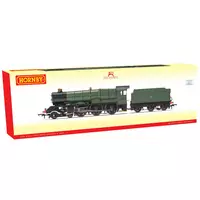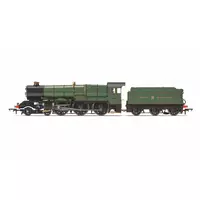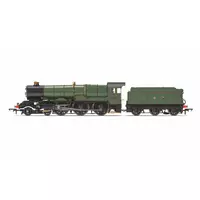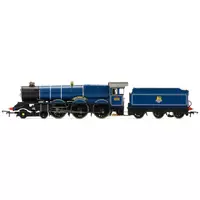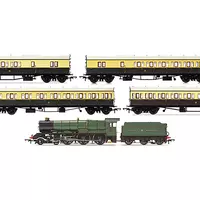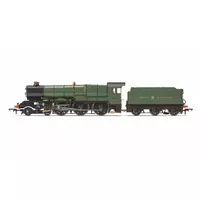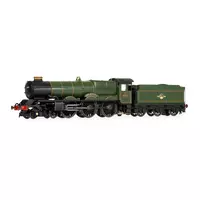Manufacturer catalogue image - please note that pre-release images may be CAD renders or CGI images rather than photographs
Prototype Eras
Era 4 (1948 to 1956) British Railways Early Crest
Era 5 (1957 to 1966) British Railways Late Crest
Manufacturer description
To view the full range of King Class locomotives in the mid-1920s, with train load sizes increasing to and from the South West, the Great Western Railway were faced with the need for even more powerful locomotives, capable of hauling the heavy expresses at an average speed of 60 mph. The main routes were limited to a 20 ton axle weight though, so a number of the Great Western's routes had to be upgraded, including the strengthening of some bridges before the Great Western's General Manager, Sir Felix Pole, would give his Chief Mechanical Engineer, Charles Collett, permission to proceed with the design and construction of a 'Super-Castle'.
The result was the King class 4-6-0, which emerged from Swindon works in June 1927, a design that increased the length and wheelbase over the Castle class, necessary to accommodate the new WA designated boiler. The driving and bogie wheels were reduced in size from that of the Castles and the boiler working pressure increased to 250lb with a larger diameter cylinder and a longer stroke. The Great Western promoted the new Kings as 'the most powerful passenger locomotives in the country' and at 29ft 5in and weighing 89 tons, the class probably represented the limit of the 4-6-0 design.
Initially, twenty locomotives were ordered, the first six being built at Swindon in June and July 1927, followed by the remaining fourteen locomotives between February and July, 1928. The final ten locomotives of the class were not to be built for another two years, being constructed between May and August 1930 and they incorporated some minor changes from the earlier engines. The decision to name the new class after the Kings of England was agreed by Collett in May 1927, being named in reverse chronological order starting from King George V. Only two engines were renamed with 6028 King Henry II becoming King George VI on January 12, 1937 and 6029 King Stephen becoming King Edward VIII on May 14, 1936.
Locomotive 6002, King William IV, was built in July 1927 at Swindon Works and was allocated initially to Plymouth Laira Shed. The Alfloc water treatment was fitted in 1954, with the double chimney being fitted in March 1956. King William IV spent spells at sheds across the Great Western region, from Plymouth Laira, Newton Abbot and Old Oak Common, to Wolverhampton Stafford Road from where it was withdrawn in September 1962. Sold for scrap to Cox and Danks of Oldbury, King William IV was cut up in February 1963.
Catalogue listing
Model details
Prototype information
* Class names often change over the lifespan of a locomotive, so this is not necessarily the class name used by the operator in the period modelled.
Supplier links are provided for your convenience and do not guarantee that the product is currently available. RailwayModels.uk is not a representative of these suppliers, but may receive a commission when purchases are made through links on this page.

